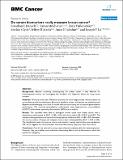| dc.contributor.author | Mukherjee, Sayan | |
| dc.contributor.author | Yurkovetsky, Zoya | |
| dc.contributor.author | Clyde, Merlise | |
| dc.contributor.author | Marks, Jeffrey R. | |
| dc.contributor.author | Lokshin, Anna E. | |
| dc.contributor.author | Lo, Joseph Y. | |
| dc.contributor.author | Jesneck, Jonathan Lee | |
| dc.date.accessioned | 2012-03-09T19:34:42Z | |
| dc.date.available | 2012-03-09T19:34:42Z | |
| dc.date.issued | 2009-05 | |
| dc.date.submitted | 2008-09 | |
| dc.identifier.issn | 1471-2407 | |
| dc.identifier.uri | http://hdl.handle.net/1721.1/69635 | |
| dc.description.abstract | Background
Because screening mammography for breast cancer is less effective for premenopausal women, we investigated the feasibility of a diagnostic blood test using serum proteins.
Methods
This study used a set of 98 serum proteins and chose diagnostically relevant subsets via various feature-selection techniques. Because of significant noise in the data set, we applied iterated Bayesian model averaging to account for model selection uncertainty and to improve generalization performance. We assessed generalization performance using leave-one-out cross-validation (LOOCV) and receiver operating characteristic (ROC) curve analysis.
Results
The classifiers were able to distinguish normal tissue from breast cancer with a classification performance of AUC = 0.82 ± 0.04 with the proteins MIF, MMP-9, and MPO. The classifiers distinguished normal tissue from benign lesions similarly at AUC = 0.80 ± 0.05. However, the serum proteins of benign and malignant lesions were indistinguishable (AUC = 0.55 ± 0.06). The classification tasks of normal vs. cancer and normal vs. benign selected the same top feature: MIF, which suggests that the biomarkers indicated inflammatory response rather than cancer.
Conclusion
Overall, the selected serum proteins showed moderate ability for detecting lesions. However, they are probably more indicative of secondary effects such as inflammation rather than specific for malignancy. | en_US |
| dc.description.sponsorship | United States. Dept. of Defense. Breast Cancer Research Program (Grant No. W81XWH-05-1-0292) | en_US |
| dc.description.sponsorship | National Institutes of Health (U.S.) (R01 CA-112437-01) | en_US |
| dc.description.sponsorship | National Institutes of Health (U.S.) (NIH CA 84955) | en_US |
| dc.language.iso | en_US | |
| dc.publisher | Springer (Biomed Central Ltd.) | en_US |
| dc.relation.isversionof | http://dx.doi.org/10.1186/1471-2407-9-164 | en_US |
| dc.rights | Creative Commons Attribution | en_US |
| dc.rights.uri | http://creativecommons.org/licenses/by/2.0 | en_US |
| dc.source | BioMed Central | en_US |
| dc.title | Do serum biomarkers really measure breast cancer? | en_US |
| dc.type | Article | en_US |
| dc.identifier.citation | Jesneck, Jonathan L et al. “Do Serum Biomarkers Really Measure Breast Cancer?” BMC Cancer 9.1 (2009): 164. Web. 9 Mar. 2012. | en_US |
| dc.contributor.department | Massachusetts Institute of Technology. Laboratory for Manufacturing and Productivity | en_US |
| dc.contributor.approver | Jesneck, Jonathan | |
| dc.contributor.mitauthor | Jesneck, Jonathan Lee | |
| dc.relation.journal | BMC Cancer | en_US |
| dc.eprint.version | Final published version | en_US |
| dc.type.uri | http://purl.org/eprint/type/JournalArticle | en_US |
| eprint.status | http://purl.org/eprint/status/PeerReviewed | en_US |
| dspace.orderedauthors | Jesneck, Jonathan L; Mukherjee, Sayan; Yurkovetsky, Zoya; Clyde, Merlise; Marks, Jeffrey R; Lokshin, Anna E; Lo, Joseph Y | en |
| mit.license | PUBLISHER_CC | en_US |
| mit.metadata.status | Complete | |
